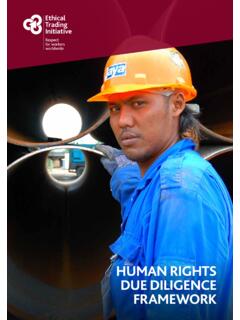Transcription of Trafficking in Persons for the Purpose of Organ Removal
1 ASSESSMENT TOOLKIT Trafficking in Persons for the Purpose of Organ Removal UNITED NATIONS Vienna, 2015 The description and classification of countries and territories in this study and the arrangement of the material do not imply the expression of any opinion whatsoever on the part of the Secretariat of the United Nations concerning the legal status of any country, territory, city or area, or of its authorities, or concerning the delimitation of its frontiers or boundaries, or regarding its economic system or degree of development.
2 United Nations Office on Drugs and Crime, 2015 Acknowledgements This assessment toolkit was developed by the UNODC Human Trafficking and Migrant Smuggling Section under the leadership of Mr. Ilias Chatzis and the substantive coordination of Ms. Silke Albert. Two expert group meetings held in Vienna, Austria, in June 2010 and December 2013, elaborated concepts and reviewed drafts of the toolkit. The meetings brought together more than 30 experts from national governments, hospitals and other medical institutions, academia, as well as inter-governmental and non-governmental organizations.
3 UNODC expresses its gratitude to the experts who participated in the expert group meetings and who substantially contributed to the present toolkit: Mr. Omar Al-Thaher (Jordan),Ms. Maria Amihan Abueva (the Philippines), Mr. Mikhail Bedunkevich (Belarus), Mr. Bhanu Bhaskar (India), Mr. James Bowman (United States of America), Ms. Alina Bra oveanu (Council of Europe/GRETA), Ms. Carla Bury (United States of America), Ms. Aim e Comrie (Organization for Security and Co-operation in Europe-OSCE), Ms. Tatiana Tutida Ribeiro Correa (Brazil), Mr.
4 Gabriel Danovitch (Declaration of Istanbul Custodian Group),Mr. Timothy Delvecchio (OSCE), Ms. Veronica Feican (Ecuador), Ms. Marta Lopez Fraga (Council of Europe/European Directorate Quality of Medicines & Health Care), Mr. Martin Gunnarson (Sweden), Mr. Steve Harvey (EUROPOL), Mr. Louis Helberg (South Africa), Mr. Paul Holmes (United Kingdom), Mr. Ninoslav Ivanovski (the former Yugoslav Republic of Macedonia), Ms. Jessica de Jong (the Netherlands), Mr. Bassam Kandeleft (Israel), Mr.
5 Jesper Lund (INTERPOL), Ms. Susanne Lundin (Sweden), Mr. Igor Miloserdov (Russian Federation), Ms. Sharon Mishal (Israel), Mr. Dave Newton (United Kingdom), Mr. Luc No lle (World Health Organization), Ms. Darlene Pajarito (the Philippines), Mr. Jonathan Ratel (United Kingdom/Canada), Ms. Nancy Scheper-Hughes (United States of America), Mr. Milbert Shin (OSCE), Ms. Hana Snajdrova (OSCE), Mr. Michael Surgalla (United States of America). Special thanks are extended to Ms. Nicole Maric (UNODC), for her vital guidance and advice, as well as to Mr.
6 Martin Fowke, Ms. Tatiana Balisova, Ms. Kanako Emoto, and Mr. Fabrizio Sarrica (UNODC), and to Ms. Marika McAdam and Ms. Frederike Ambagtsheer (consultants), who provided substantial written input to the toolkit. 2 Contents Scope, Objectives and Structure of the Assessment Toolkit .. 5 PART 1 Trafficking in Persons for the Purpose of Organ Removal .. 7 1. Introduction .. 7 Basic information on Organ transplantation .. 7 International standards governing donation and transplantation .. 8 A market for Trafficking in Persons for Organ Removal .. 10 Need for a strengthened response.
7 13 2. International Legal and Other Instruments .. 14 Definition of Trafficking in Persons for the Purpose of Organ Removal .. 14 The issue of consent .. 15 Trafficking in children for Organ Removal .. 16 Trafficking in Persons for the Purpose of Organ Removal versus Organ Trafficking .. 17 Prohibition of financial gain .. 19 Non-legally binding instruments .. 22 3. Overview of Persons Involved .. 24 Recruiters (and brokers) .. 28 Medical professionals .. 30 Actors in the health care and other sectors .. 33 Organ recipients .. 36 Cooperation among actors.
8 40 Organ suppliers .. 41 4. Good Practice Responses and Recommendations .. 46 Prevention .. 46 Legislation .. 48 Regulation and monitoring .. 49 Detection, investigation, prosecution and adjudication .. 50 Protection and assistance ..53 Cooperation and coordination .. 55 Data collection and research .. 55 PART 2 Assessment Tools .. 57 1. Introduction .. 57 3 TOOL 1 - Recommendations on the care of living kidney donors .. 59 TOOL 2 Direct questions for immediate assistance for victims .. 62 TOOL 3 General considerations concerning interviews of Organ recipients and suppliers in suspected cases of Trafficking in Persons for Organ Removal for criminal justice practitioners.
9 64 TOOL 4 Identifying and understanding concrete, potential Trafficking for Organ Removal situations .. 70 TOOL 5 Considerations in evaluation of potential Organ donors .. 78 TOOL 6 Assessment of screening procedures .. 81 TOOL 7 Full and informed consent .. 84 TOOL 8 - Identification of potential recipients of organs from trafficked Persons .. 87 TOOL 9 Legal assessment .. 90 TOOL 10 Assistance and protection measures in place for victims of Trafficking in Persons for Organ Removal .. 95 TOOL 12 Direct interview with public servants in the justice sector.
10 101 TOOL 13 Direct interview with medical and health care professionals and 104 TOOL 14 Direct interview with criminal justice practitioners .. 109 TOOL 15 Direct interview with employees of health insurance companies .. 118 TOOL 16 Direct interview with civil society, social and NGOs workers, others .. 120 TOOL 17 Direct interview with embassy and consulates 124 TOOL 18 Direct interview with employees of travel industry .. 128 Endnotes .. 130 Resources and Bibliography .. 135 4 Abbreviations and Acronyms CoE Council of Europe EGM Expert Group Meeting NGO Non-governmental organization OSCE Organization for Security and Co-operation in Europe WHA World Health Assembly WHO World Health Organization UN United Nations UNODC United Nations Office on Drugs and Crime 5 Scope, Objectives and Structure of the Assessment Toolkit The present toolkit deals with Trafficking in Persons for the Purpose of Organ Removal , as defined by the Protocol to Prevent.










